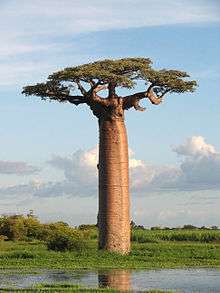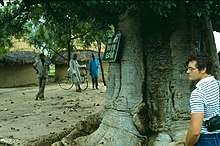Adansonia
Adansonia is a genus made up of eight species of medium to large deciduous trees known as baobabs (/ˈbeɪoʊˌbæb/). They are native to Madagascar, mainland Africa[2] and Australia.[3] Trees have also been introduced to other regions such as Asia.[2][4][5] The generic name honours Michel Adanson, the French naturalist and explorer who described Adansonia digitata.[6] The baobab is also known as the "upside down tree", a name that originates from several myths.[7] They are among the most long-lived of vascular plants[8] and have large flowers that are reproductive for a maximum of 15 hours.[9] The flowers open around dusk; opening so quickly that movement can be detected by the naked eye and are faded by the next morning.[9] The fruits are large, oval to round and berry-like and hold kidney-shaped seeds in a dry, pulpy matrix.
| Adansonia | |
|---|---|
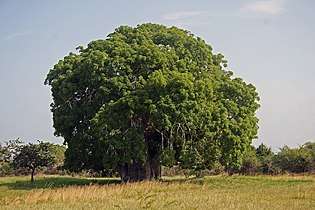 | |
| Adansonia digitata in Tanzania | |
| Scientific classification | |
| Kingdom: | Plantae |
| Clade: | Tracheophytes |
| Clade: | Angiosperms |
| Clade: | Eudicots |
| Clade: | Rosids |
| Order: | Malvales |
| Family: | Malvaceae |
| Subfamily: | Bombacoideae |
| Genus: | Adansonia L.[1] |
| Species | |
|
See Species section | |
In the early 21st century, baobabs in southern Africa began to die off rapidly from a cause yet to be determined. Scientists believe it is unlikely that disease or pests were able to kill many trees so rapidly, and some speculated that the die-off was a result of dehydration from global warming.[10][11]
Description
General
Baobabs are long-lived deciduous, small to large trees with broad trunks and compact crowns. Young trees usually have slender, tapering trunks, often with a swollen base. The trunk is made of fibrous wood arranged in concentric rings. Tree diameter fluctuates with rainfall so it is thought that water may be stored in the trunk.[9] Baobab trees have two types of shoots – long, green vegetative ones, and stout, woody reproductive ones.[9]
Leaves
Leaves are palmately compound in mature trees, but seedlings and regenerating shoots may have simple leaves. The transition to compound leaves comes with age and may be gradual. Leaflets may have toothed or smooth edges and may be hairless or have simple to clumped hairs. Baobabs have stipules at the base of the leaves, but the stipules are soon shed in most species.[9]
Flowers
Flowers are born near the tips of reproductive shoots, in the axils of the leaves. There is usually only a singe flower in an axil, but sometimes flowers occur in pairs. They are large, showy and strongly scented. They only open near dusk. Opening is rapid and movement of the flower parts is fast enough to be visible. Flowers may remain attached to the trees for several days, but the reproductive phase is very short, with pollen shed during the first night and stigmas shriveled by the morning. The flower is made up of an outer 5-lobed calyx, and an inner ring of petals set around a fused tube of stamens.[9] The calyx is usually green (brown in A. grandidieri Baill.) [9] and made up of 5 lobes that in bud are joined almost to the tip. As the flower opens, the calyx lobes split apart and become coiled or bent back (reflexed) at the base of the flower. Sometimes the lobes do not separate cleanly, distorting the shape of the flower as they bend back. The calyx lobes remain fused at the base, leaving a feature (calyx tube) that has nectar-producing tissue and that is cup-shaped, flat or tubular; the form of the calyx tube varies with species.[9] The flowers have a central tube (staminal tube) made up of fused stalks of stamens (filaments), with unfused filaments above. A densely hairy ovary is enclosed in the staminal tube, and a long style tipped with a stigma emerges from the filaments. Petals are set near the base of the staminal tube and are variable in shape and colour. The flowers, when fresh, may be white, cream, bright yellow or dark red, but fade quickly, often turning reddish when dried.[9]
Fruit
The fruit of the baobabs is one of their distinguishing features. It is large, oval to round, and berry-like. It has a dry, hard outer shell of variable thickness. In most species, the shell is indehiscent (does not break open easily). A. gibbosa is the only species with fruits that crack while still on the tree, so then tend to break open upon landing on the ground. Inside the outer shell, kidney-shaped seeds are set in a dry pulp.[9]
Species
As of July 2020, there were considered to be eight species of Adansonia, with six endemic to Madagascar, one native to mainland Africa and the Arabian Peninsula, and one native to Australia. The mainland African species (Adansonia digitata) also occurs on Madagascar, but it is not a native of that island. Baobabs were introduced in ancient times to south Asia and during the colonial era to the Caribbean. They are also present in the island nation of Cape Verde.[7] A ninth species was described in 2012 (Adansonia kilima Pettigrew, et al.)[12] but is no longer recognized as a distinct species.[13] The African and Australian baobabs are almost identical despite having separated more than 100 million years ago, probably getting to Australia from Africa by oceanic dispersal.[14]
| Species | Common names | Range |
|---|---|---|
| Adansonia digitata L. (also includes Adansonia kilima[12]) | African baobab, dead-rat-tree, monkey-bread-tree, montane African baobab | western, northeastern, central & southern Africa[16] |
| Adansonia grandidieri Baill. | Grandidier's baobab, giant baobab | west central Madagascar[17] |
| Adansonia gregorii F.Muell. (syn. A. gibbosa) | boab, Australian baobab, bottletree, cream-of-tartar-tree, gouty-stem | northwestern Australia |
| Adansonia madagascariensis Baill. | Madagascar baobab | northwest and north Madagascar[18] |
| Adansonia perrieri Capuron | Perrier's baobab | northern Madagascar[18] |
| Adansonia rubrostipa Jum. & H.Perrier (syn. A. fony) | fony baobab | central to south part of western Madagascar[18] |
| Adansonia suarezensis H.Perrier | Suarez baobab | northern Madagascar[18] |
| Adansonia za Baill. | za baobab | west and southwest Madagascar[18] |
Habitat
The Malagasy species are important components of the Madagascar dry deciduous forests. Within that biome, Adansonia madagascariensis and A. rubrostipa occur specifically in the Anjajavy Forest, sometimes growing out of the tsingy limestone itself. A. digitata has been called "a defining icon of African bushland".[19] The tree also grows wild in Sudan in the regions of Darfur and the state of Kordofan . The locals call it "Gongolaze" and use its fruits as food and medicine and use the tree trunks as reservoirs to save water.
Ecology
Baobabs store water in the trunk (up to 120,000 litres or 32,000 US gallons) to endure harsh drought conditions.[20] All occur in seasonally arid areas, and are deciduous, shedding their leaves during the dry season. Across Africa, the oldest and largest baobabs began to die in the early 21st century, likely from a combination of drought and rising temperatures.[10] The trees appear to become parched, then become dehydrated and unable to support their massive trunks.[11]
Baobabs are important as nest sites for birds, in particular the mottled spinetail[21] and four species of weaver.[22]
Notable Trees
Radiocarbon dating has provided data on a few individuals of A. digitata. The Panke baobab in Zimbabwe was some 2,450 years old when it died in 2011, making it the oldest angiosperm ever documented, and two other trees – Dorslandboom in Namibia and Glencoe in South Africa – were estimated to be approximately 2,000 years old.[8] Another specimen known as Grootboom was dated and found to be at least 1275 years old.[19][23] The Glencoe baobab, a specimen of A. digitata in Limpopo Province, South Africa, was considered to be the largest living individual, with a maximum circumference of 47 m (154 ft)[24] and a diameter of about 15.9 m (52 ft). The tree has since split into two parts, so the widest individual trunk may now be that of the Sunland baobab, or Platland tree, also in South Africa. The diameter of this tree at ground level is 9.3 m (31 ft) and its circumference at breast height is 34 m (112 ft).[8]
Food uses
.jpg)
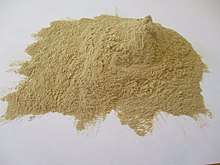
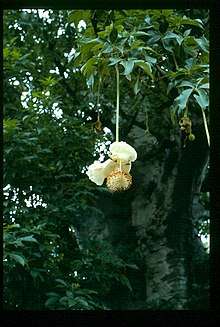
Leaves
Leaves may be eaten as a leaf vegetable.[19]
Fruit
- The fruit has a velvety shell and is about the size of a coconut, weighing about 1.5 kilograms (3.3 lb), but is not as globular (sphere shaped). The white pith in the fruit tastes like sorbet.[25] It has an acidic, tart, citrus flavor.[26] It is a good source of vitamin C, potassium, carbohydrates, and phosphorus.[27]
- The dried fruit powder of Adansonia digitata, baobab powder, contains about 11% water, 80% carbohydrates (50% fiber),[28] and modest levels of various nutrients, including riboflavin, calcium, magnesium, potassium, iron, and phytosterols, with low levels of protein and fats.[26][29][30] Vitamin C content, described as variable in different samples, was in a range of 74 to 163 milligrams (1.14 to 2.52 gr) per 100 grams (3.5 oz) of dried powder.[26]
- In Angola, the dry fruit is usually boiled and the broth is used for juices or as the base for a type of ice cream known as gelado de múcua.
- In Zimbabwe, the fruit is used in traditional food preparations which include "eating the fruit fresh or crushed crumbly pulp to stir into porridge and drinks".[31]
- In the European Union (EU), prior to commercial approval, baobab fruit powder was not available for use as a food ingredient, as legislation from 1997 dictated that foods not commonly consumed in the EU would have to be formally approved first. In 2008, baobab dried fruit pulp was authorized in the EU as a safe food ingredient,[32] and later in the year was granted GRAS (generally recognized as safe) status in the United States.[33]
Seed
- The seeds of some species are a source of vegetable oil,[34][35]
- The fruit pulp and seeds of A. grandidieri[34] and A. za are eaten fresh.[35]
Tree
In Tanzania, the dry pulp of A. digitata is added to sugarcane to aid fermentation in brewing (beermaking).[36]
Other uses
Some baobab species are sources of fiber, dye, and fuel. Indigenous Australians used the native species A. gregorii for several products, making string from the root fibers and decorative crafts from the fruits.[37] Oil from the seed is also used in cosmetics, particularly in moisturizers.[38]
Gallery
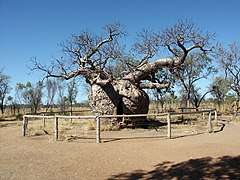
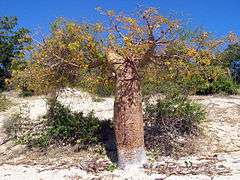
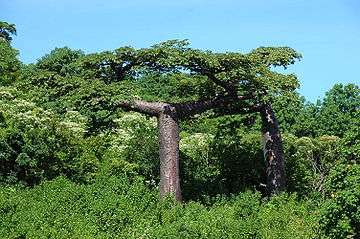
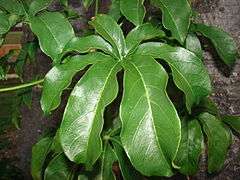 Adansonia digitata leaf
Adansonia digitata leaf.jpg) Adansonia digitata flower
Adansonia digitata flower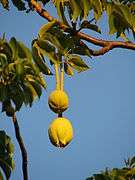 Adansonia digitata hanging fruit
Adansonia digitata hanging fruit- Adansonia rubrostipa, inside the fruit
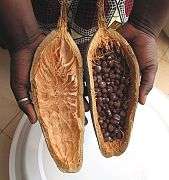 Adansonia digitata seeds from the fruit
Adansonia digitata seeds from the fruit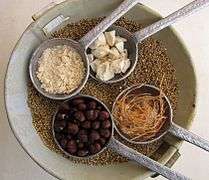 Elements of the fruit pulp of Adansonia digitata (clockwise from top right): whole fruit pulp chunks, fibers, seeds, powder from the pulp
Elements of the fruit pulp of Adansonia digitata (clockwise from top right): whole fruit pulp chunks, fibers, seeds, powder from the pulp
References
- "Genus: Adansonia L." Germplasm Resources Information Network. United States Department of Agriculture. 12 November 2008. Archived from the original on 30 May 2010. Retrieved 14 January 2011.
- https://www.abc.net.au/news/2018-08-07/boabs-come-africa-baobabs-evolution/10060946
- Tropicos.org. Missouri Botanical Garden. 8 Jul 2020 http://www.tropicos.org
- https://www.tripsavvy.com/fun-facts-about-the-baobab-tree-1454374
- https://madagascar-tourisme.com/en/what-to-do/fauna-and-flora/baobab/
- Eggli, U.; Newton, L.E. (2004). Etymological Dictionary of Succulent Plant Names. Springer Berlin Heidelberg. p. 3. ISBN 978-3-540-00489-9.
- Wickens, G. E.; Lowe, P. (2008). The Baobabs: Pachycauls of Africa, Madagascar and Australia. Springer Verlag. ISBN 978-1-4020-6430-2. OCLC 166358049.
- Adrian Patrut et al. (2018) The demise of the largest and oldest African baobabs. Nature Plants 4: 423–426. DOI: 10.1038/s41477-018-0170-5
- Baum, D.A., 1995, A Systematic Revision of Adansonia (Bombacaceae). Annals of the Missouri Botanical Garden , 1995, Vol. 82, No. 3 (1995), pp. 440-471
- Ed Yong (11 June 2018). "Trees That Have Lived for Millennia Are Suddenly Dying The oldest baobabs are collapsing, and there's only one likely explanation". The Atlantic. Retrieved 12 June 2018.
- Rachel Nuwer (12 June 2018). "Last March of the 'Wooden Elephants': Africa's Ancient Baobabs Are Dying". The New York Times.
- Pettigrew, J. D.; et al. (2012). "Morphology, ploidy and molecular phylogenetics reveal a new diploid species from Africa in the baobab genus Adansonia (Malvaceae: Bombacoideae)" (PDF). Taxon. 61 (6): 1240–1250. doi:10.1002/tax.616006.
- Cron, Glynis & Karimi, Nisa & Glennon, Kelsey & Udeh, Chukwudi & Witkowski, E & Venter, Sarah & Assogbadio, A & Baum, David. (2016). "One African baobab species or two? A re-evaluation of Adansonia kilima." South African Journal of Botany. 103. 312. 10.1016/j.sajb.2016.02.036.
- Baum, David A.; Small, Randall L.; Wendel, Jonathan F. (1998). "Biogeography and floral evolution of baobabs (Adansonia, Bombacaceae) as inferred from multiple data sets" (PDF). Syst Biol. 47 (2): 181–207. doi:10.1080/106351598260879. PMID 12064226.
- "GRIN Species Records of Adansonia". Germplasm Resources Information Network. United State Department of Agriculture. Archived from the original on 24 September 2015. Retrieved 14 January 2011.
- Gardner, Simon; Sidisunthorn, Pindar; Lai, Ee May (2011). Heritage Trees of Penang. Penang: Areca Books. ISBN 978-9-675-71906-6.
- Ravaomanalina, H.; Razafimanahaka, J. (2016). "Adansonia grandidieri". IUCN Red List of Threatened Species. 2016: e.T30388A64007143. doi:10.2305/IUCN.UK.2016-2.RLTS.T30388A64007143.en.
- Behrens, K. and K. Barnes. 2016. Wildlife of Madagascar. Wild guides, Princeton University Press.
- "Adansonia digitata (baobab)". Royal Botanic Gardens, Kew. Archived from the original on 20 February 2014. Retrieved 8 June 2014.
- "The Baobab tree in Senegal". Archived from the original on 4 October 2008. Retrieved 1 October 2008.
- "Species text in The Atlas of Southern African Birds" (PDF). Archived from the original (PDF) on 21 October 2012. Retrieved 30 October 2014.
- "Weavers breeding in baobabs". Animal Demography Unit, Department of Biological Sciences, University of Cape Town, South Africa. Archived from the original on 15 September 2015. Retrieved 30 October 2014.
- Patrut, A., et al. (2010). Fire history of a giant African baobab evinced by radiocarbon dating. Archived 22 October 2014 at the Wayback Machine Radiocarbon 52(2), 717–26.
- "Big Baobab Facts". Archived from the original on 6 January 2008. Retrieved 8 January 2008.
- "Adansonia gregorii". Australian Tropical Rainforest Plants. Retrieved 20 July 2020.
- UK Advisory Committee on Novel Foods and Processes (July 2008). "Baobab dried fruit pulp. EC No. 72; August 2006: Application from PhytoTrade Africa to approve baobab dried fruit pulp as a novel food ingredient. Authorised July 2008". UK Food Standards Agency. Retrieved 3 June 2012.
- "Baobab: Benefits, nutrition, dietary tips, and risks". Medical News Today. Retrieved 20 June 2018.
- "Nutrition Facts". nutritionvalue.org. Retrieved 20 July 2020.
- Osman, M. A. (2004). "Chemical and nutrient analysis of baobab (Adansonia digitata) fruit and seed protein solubility". Plant Foods Hum Nutr. 59 (1): 29–33. CiteSeerX 10.1.1.587.6400. doi:10.1007/s11130-004-0034-1. PMID 15675149.
- Chadare, F. J.; et al. (2009). "Baobab food products: a review on their composition and nutritional value". Crit Rev Food Sci Nutr. 49 (3): 254–74. doi:10.1080/10408390701856330. PMID 19093269.
- "South African villagers tap into trend for 'superfood' baobab". AFP. 24 September 2018. Retrieved 29 September 2018.
- "Baobab dried fruit pulp". UK Food Standards Agency. 2008. Retrieved 3 June 2012.
- "GRAS Notice No. GRN 273". US Food and Drug Administration. 25 July 2009. Retrieved 3 May 2018.
- Ambrose-Oji, B. and N. Mughogho. 2007. Adansonia grandidieri Baill. Archived 7 April 2014 at the Wayback Machine In: van der Vossen, H. A. M. and G. S. Mkamilo (Eds). PROTA 14: Vegetable oils/Oléagineux. PROTA, Wageningen, Netherlands.
- Ambrose-Oji, B. and N. Mughogho. 2007. Adansonia za Baill. Archived 2 April 2015 at the Wayback Machine In: van der Vossen, H. A. M. and G. S. (Eds). PROTA 14: Vegetable oils/Oléagineux. PROTA, Wageningen, Netherlands.
- Sidibe, M., et al. Baobab, Adansonia digitata L. Volume 4 of Fruits for the Future. International Centre for Underutilised Crops, 2002.
- "Dance of the baob". The Australian Women's Weekly. National Library of Australia. 2 February 1966. p. 26. Retrieved 11 January 2012.
- Vermaak, Ilze; Kamatou, Guy; Komane-Mofokeng, B.; Alvaro, Viljoen; Beckett, Katie (2011). "African seed oils of commercial importance – Cosmetic applications". South African Journal of Botany. 77 (4): 920–933. doi:10.1016/j.sajb.2011.07.003.
| Wikimedia Commons has media related to Adansonia. |
| Wikispecies has information related to Adansonia |
| Wikisource has the text of the 1911 Encyclopædia Britannica article Baobab. |
